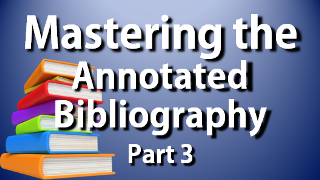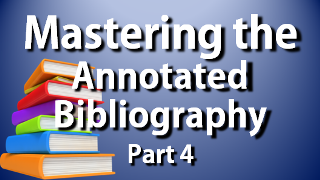
Writing the Annotated Bibliography
An annotated bibliography contains a list of sources followed by a summary (annotation) of each one. The purpose of the annotation is for you to record information from the source and to interact with it in order to develop your own opinions and insights that will form the basis of your paper. These four videos walk you through the creation of an annotated bibliography. |
 |
 |
 |
What
Are the Uses of an
Annotated Bibliography?
It's a personal
database: In one
document you
compile information from each source you've
found. Thus, an annotated bibliography
becomes a “database” that you draw upon for all the
information you need to write your paper.
It's a diary: The
annotation
you
write is not merely a summary. It should also
include
your personal reactions to the source.
It's
an accelerator: By
doing an annotated bibliography,
you have a source citation in the correct format and source
information in your own words and thoughts. You are ready to begin
writing.
What Are the Parts of an
Annotated Bibliography?
Part 1:
The source entry is the citation format as it will appear on
the
reference list of your paper.
Part 2: Below the citation is the annotation--information from the source and your reaction to it. Your goal is to summarize any information of value when you write your paper. This info can be facts, stats, quotes, examples and ideas. Be sure the info is reliable and not out of date for your topic.
Part 2: Below the citation is the annotation--information from the source and your reaction to it. Your goal is to summarize any information of value when you write your paper. This info can be facts, stats, quotes, examples and ideas. Be sure the info is reliable and not out of date for your topic.
Breaking Down the Annotation Paragraph:
There are different ways to construct your annotation. Depending on the instructions given to you, the annotation may include some of all of the following:
-
Summary: a description in your own words of what this source is about: its topic, arguments, and findings.
-
Assessment: your opinions on the usefulness and legitimacy of this source. Did you find it to be helpful in proving what you are setting out to prove or argue? Why or why not? Is there a bias in the source to be aware of?
-
Reflection: how does this source has impact you? Does it help shape your opinion? What did you learn from it that surprised or impressed you? Most important, how might this source be used in your paper?
All annotated bibliographies include a summary, but they may or may not have the assessment and reflection.
Here’s an example annotation to help get you thinking about the kinds of sentences, language, ideas, and observations that might find their way into a source annotation. (Please note: because of LEO formatting limitations, the spacing and indents on this example may not read correctly on your computer.)
| Hill, T. D., Kaplan, L. M.,
French, M. T., & Johnson, R. J. (2010). Victimization in early
life and mental health in adulthood:
An examination of the
influences of psychosocial resources. Journal
Of Health &
Social Behavior, 51(1),
48-63. Retrieved Jan. 15, 2015 from doi:10.1177/002214650936119
The authors found that situations which make children feel less than equal to their peers can harm their mental health as adults. The authors also found that one in four children suffer from self-esteem issues, and one in three live in financial hardship that affects their self esteem. The study provides evidence from a peer-reviewed journal of the effect of poverty on juvenile delinquency: The cycle starts when the child is young enough to be aware of self esteem. The poverty and inequality experienced shape many children into maladjusted teens and young adults. The authors conclude that poverty is a root cause of juvenile delinquency. Important article about causes of delinquency from peer-reviewed journal. |
Notice that the first part of the paragraph is a summary. Then the student makes a notation that adds an evaluation of the article and its use. This annotation is similar to the kinds you will write as you evaluate sources that you find for your paper.
Assignment
Using the above as a model, please post a source citation followed by your annotation of it. It should be a source that you are planning to use for this assignment. Be sure to include:
- a
proper reference citation
- a
short summary
- your
reaction to the source: distinctive
features about it, why it may or may not be useful for you.